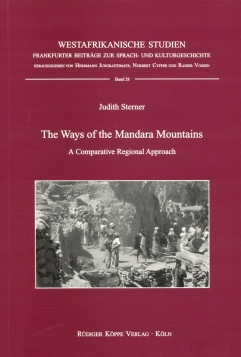
The Ways of the Mandara Mountains
A Comparative Regional Approach
Author: Judith Sterner. Series edited by: Herrmann Jungraithmayr, Norbert Cyffer, Rainer Voßen.
Series: WeStu Westafrikanische Studien Volume 28
200312 pp. Roman, 317 pp.
4 maps, 2 illustrations, 20 tables, appendix: Sources on the Mandara Mountains, Information on Ethnic Groups
Text language(s): English
Format: 160 x 240 mm
540 g
Paperback
€ 69.80
Buy 'The Ways of the Mandara Mountains' as a downloadable PDF document directly from our online shop »
Order 'The Ways of the Mandara Mountains' as print edition »
The Mandara Mountains, a mountain range that extends over the border to northern Cameroon and north-eastern Nigeria, are commonly known within ethnographic literature as a research field that stands out for its strong heterogeneous cultural situation. The present work presents the results of two years of field research of the author during 1984 and 1996. In the first place, her interest for the region was focused on archaeological research, but soon turned into a newly discovered cultural interest.
Influenced by different historical situations of French colonization on the one hand and of English colonization on the other, the Mandara mountains seem to be destined for a comparative regional study. Judith Sterner chose the villages of Sirak in Cameroon and Sukur in Nigeria to be the centre of her research.
After the embedding of the concerning societies into their historical and regional context, they are opposed to each other in their social (smithy / potters), political (chiefs / dignitary), and religious (rain maker) organisations and are explained by further aspects of material culture (houses / containers) and different traditional ceremonies (initiation, cattle, and cleaning ceremonies).
In the appendix this study offers numerous charts of kinship terminology, traditional ceremonies, ritual objects, functions and titles of dignitaries, origins of honorary titles, functions within the royal household, as well as sketch-maps of farmsteads and a detailed appendix about the situation of written sources in the region.
The present edition was derived from the PhD thesis of the author at the School of Oriental and African Studies SOAS, University of London.
Under these links you will find descriptions of further Central Chadic / Biu-Mandara languages and cultures:
Accompanying material:
- Dictionary of Hdi
(ISBN 978-3-89645-299-3 ) - Die Mafa im Spiegel ihrer oralen Literatur
(ISBN 978-3-89645-126-2 ) - Our People’s Own (Ina Lamang)
(ISBN 978-3-89645-290-0 ) - Tesserae of Borno
(ISBN 978-3-89645-018-0 ) - The Lamang Language and Dictionary
(ISBN 978-3-89645-296-2 ) - The Lamang Language and Dictionary
(ISBN 978-3-89645-294-8 ) - The Lamang Language and Dictionary
(ISBN 978-3-89645-297-9 )
Cross-reference:
- Advances in Minority Language Research in Nigeria vol. I
(ISBN 978-3-89645-426-3 ) - Dictionnaire Mofu-Gudur – Français – Fulfulde
(ISBN 978-3-89645-423-2 ) - Dictionnaire muyang–français–anglais
(ISBN 978-3-89645-431-7 ) - Topics in Chadic Linguistics III
Historical Studies
(ISBN 978-3-89645-523-9 ) - Topics in Chadic Linguistics VI
(ISBN 978-3-89645-526-0 )
Reviews
This is the book of Judy Sterner’s PhD which was directed by Richard Fardon at SOAS in London. It presents the results obtained in the course of a larger and long term research program undertaken by people from University of Calgary, Sterner and Nic David foremost among them. Sterner is refreshingly direct about the dilemmas, problems and the possibilities of undertaking anthropological, archaeological and archival research in an area spanning two nation states (Nigeria and Cameroon) and containing a large number of ethnic groups in a variety of different political and social formations. Some of the montagnard groups famously survived the FulBe razzias and remained un-islamicised until the advent of colonisation. One of the ironies of colonial rule is that it exacerbated the slave taking in some areas where indirect rule meant that FulBe district heads were supported by British and French rifles ... One of the most renowned kingdoms, Sukur, has been declared a UNESCO world heritage site and the existence of monolithic stone-works in picturesque mountains has been a lure for tourists, archaeologists and anthropologists alike. Sterner treads a course between ethno-archaeology and traditional village based studies of British social anthropology. She mainly worked in two contrasting centres but has undertaken work among several of the other groups in the Mandaras. She looks at the contrasting ideas about political centralisation, which is connected to the sacrifice of bulls kept since they were calves in small huts. They see sunlight only on the day they die. Purification brings power – to some but not all religious leaders. Similar variations among the different meaning of male initiation are traced and some of the complex connections between pots, houses, kinship and the transformers – the potters and smiths – are traced.
In the introduction, building on the work of Fardon, she considers the anthropological conundrum of regional analysis and then takes the Mandara Mountains region as a case in point. Her enthusiasm and devotion to the subject show. The book works at several different levels, both as regional synthesis and as a demonstration of how different types of analysis can mutually reinforce and illuminate.
David Zeitlyn in African Studies Review, 47/2, 2004, 147-148
Anna Siemiatkowska in Afrika und Übersee, 87/2004, 311-312
| « back | Print version | [top] |
 Books
Books Audio
Audio Biographies
Biographies Series
Series Festschrifts
Festschrifts Journals
Journals